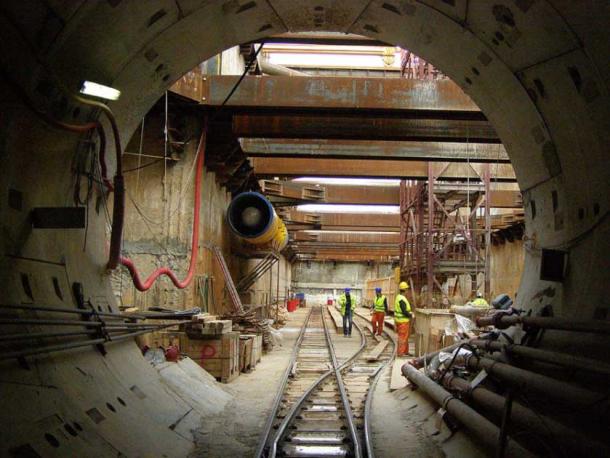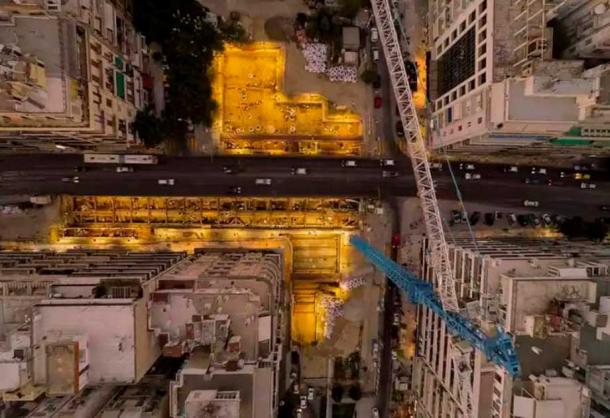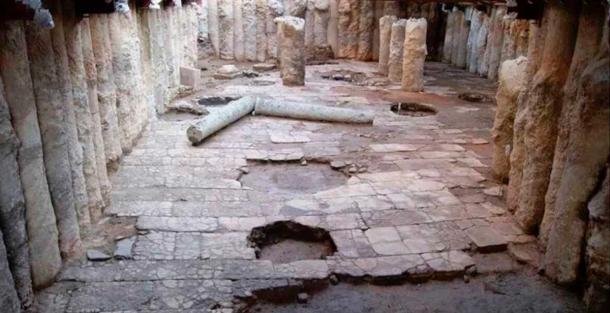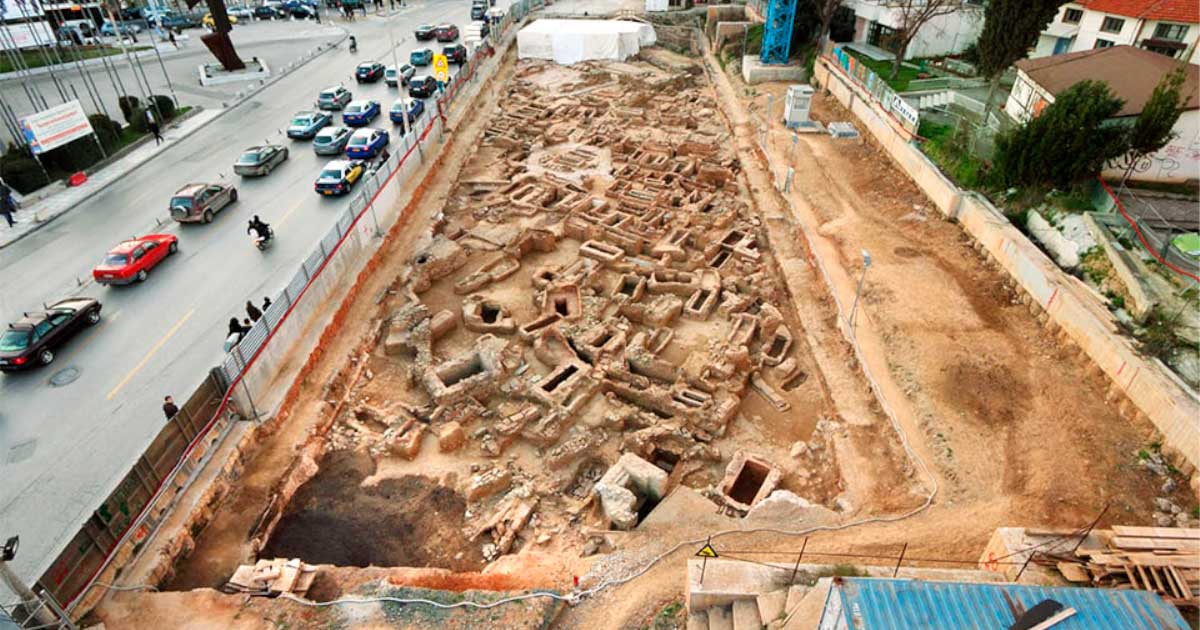Thessaloniki Metro Construction Reveals Unimaginable Treasures
The construction of local metro facilities in the ancient Greek port city of Thessaloniki have uncovered a massive stash of thousands of archaeological treasures from different periods of Thessaloniki’s history. This booty includes a decumanus (an east-west oriented road, one of the primary highways of the time), along with a Byzantine avenue.

Construction site of Thessaloniki's Metro seen from the inside of a tunnel. (Konstantinos Stampoulis / CC BY-SA 3.0 GR)
Thessaloniki’s Tryst with Momentous Greek and Roman Heritage
There are architectural remains of many 15th to 17th century buildings built on top of the remains of Hellenistic and Roman buildings – a nymphaeum, a marble paved square, a bathhouse heated by an underfloor hypocaust system and a large mosaic with intricate geometric patterns. There is even a paved road with colonnades and a line of Byzantine period shops and workshops. Stunning images of the same have been released by Attiko Metro SA.
- Subway Station or Cultural Preservation? Development Clashes with Patrimony at a World Heritage Site
- Greeks Rally to Save Ancient Road on Subway Site
The metro follows the path of the ancient decumanus, which now serves as the main historical avenue cutting through Thessaloniki, reported Arkeo News. The ancient road begins at the famed Golden Gate ( Porta Aurea), the contemporaneous Vardario Square, all the way to Kassandriotik Gate, known today as Syntrivani Square. Currently, the excavation of Thessaloniki is the largest in northern Greece and covers an area of as much as 20,000 square kilometers (7,722 sq mi).
Excavations for #Thessaloniki’s #metro construction brought to light magnificent #archaeological finds that were hidden beneath the streets of the modern city. Full story: https://t.co/1Y1pXeMcuq
.
.
.
.
.
Credit: Attiko Metro A.E pic.twitter.com/4txPnOxd79— Greek Reporter (@GreekReporter) January 10, 2023
According to Arkeonews, over 300,000 artifacts have been uncovered so far, dating to the 4th century BC, excavated from six of the twelve station sites currently under construction. This figure is likely to increase immensely as the rest of the sites are excavated. The unearthed artifacts are likely to be exhibited at the stations where they were uncovered, as well as two new museums set to be created before the end of the year.

The images released of the Thessaloniki metro excavations show the sheer scale of the project. (Attiko Metro SA)
The Thessaloniki Metro Excavation that Keeps on Giving
Owing to its strategic placement along the Thermaic Gulf of the Aegean Sea, Thessaloniki received a fair bit of human traffic throughout its history. Located in the Macedonian region, it is Greece’s second largest city today and new finds from various phases of its history keep popping up at frequent intervals, including the declaration of Thessaloniki as a “Byzantine Pompeii” during 2013 metro excavations.
In 2012 a pre-Cassandrian small town from the 4th century BC was discovered in Pylaia during excavations of the main line of the metro. It led to an ensuing 31-acre (125,000 sq m) excavation in the area, with part of the city being laid out according to the Hippodamian grid plan – an urban planning system along the line of the great cities of Macedonia, Olynthos and Pella.
In 2018, the statue of Aphrodite was discovered at the Hagia Sophia station, named after one of the oldest churches in the city, revealing an entire fountain complex around the area. Meanwhile, a Roman cemetery (2nd to 4th century AD) was discovered within the confines of Fleming Station, revealing previously unidentified settlements on the outskirts of ancient Thessaloniki.
In the same area, a 3 kilometer (1.86 mi) cemetery basilica with mosaic floors was discovered on the site of a previous structure, revealing thousands of funerary monuments from the Hellenistic to Late Antiquity period. The tombs were of all kinds – pit-shaped, box-shaped, pot burials, altars, altar-shaped constructions, single and double vaulted, clay and glass vessels, silver and gold jewelry, and all kinds of coins.

Centuries of history has been unearthed thanks to the construction of a metro line in Thessaloniki. (Attiko Metro SA)
Thessaloniki: A Checkered History of Power and Prestige
These finds are not surprising – after all, Thessaloniki was known as Symvasilévousa or the co-reigning city of the Byzantine Empire, alongside Constantinople. Prior to that too, Thessaloniki had a strong economy and established socio-political structures and institutions, with the greatest development occurring in the second half of the 4th century.
- Construction Work in Greece Uncovers 'Byzantine Pompeii'
- Sewage Construction Uncovers Head of Greek God Hermes in Athens
In 315 BC, Kassandros founded the city, though it was briefly abandoned after the fall of the Kingdom of Macedon in 168 BC. It regained its prestige and importance with the emergence of Rome as a trading hub with a vital highway running through it, known as the Via Egnatia, connecting Byzantium with Dyrrachium.
Thessaloniki reinvented itself as a seat of power away from Rome in the second half of the 5th century AD, after the fall of Rome and with the emergence of the Eastern Roman or Byzantine Empire, explained Heritage Daily. It was sacked again in 904 AD in a naval attack led by Byzantine converts to Islam led by Leo of Tripoli, and finally passed out of Byzantine hands three centuries later during the Fourth Crusade.
Top image: Thousands of artifacts and architectural remains have been uncovered during metro excavations in Thessaloniki. Source: Attiko Metro SA
By Sahir Pandey
References
Altuntas, L. 16 January 2023. “Ancient Ruins Hidden Under Thessaloniki Metro Revealed” in Arkeonews. Available at: https://arkeonews.net/ancient-ruins-hidden-under-thessaloniki-metro-revealed/
Milligan, M. 8 January 2023. “Metro Construction Reveals the Rich History of Thessaloniki” in Heritage Daily. Available at: https://www.heritagedaily.com/2023/01/metro-construction-reveals-the-rich-history-of-thessaloniki/145871
Potter, J. 13 January 2023. “Archaeologists in Greece have identified the Temple of Poseidon in Samikon” in Far Out Magazine. Available at: https://faroutmagazine.co.uk/archaeologists-greece-temple-of-poseidon/




















Comments
Thessaloniki was the seat of Galerius as Augustus during the tetrarchy times (early 4th ce.AD) and later Constantine the Great lived for a brief period in the city.
There’s NO WAY this is post-Ice Age construction. One, the construction of it would have written about by some ancient historian; two, it would NOT have been abandoned and left in ruin; and three, it’s too much work to do (creating the underground chambers, tunnels, water channeling, etc.) when living underground was NOT NECESSARY for survival. But as we know, BEFORE the Ice Age’s sudden emergence (circa 115k BC, adding the zero back to Plato’s timeline), there were NO polar ice caps, and the surface of Earth was MUCH HOTTER, necessitating a subterranean lifestyle for that entire pre-Ice Age culture.
Nobody gets paid to tell the truth.